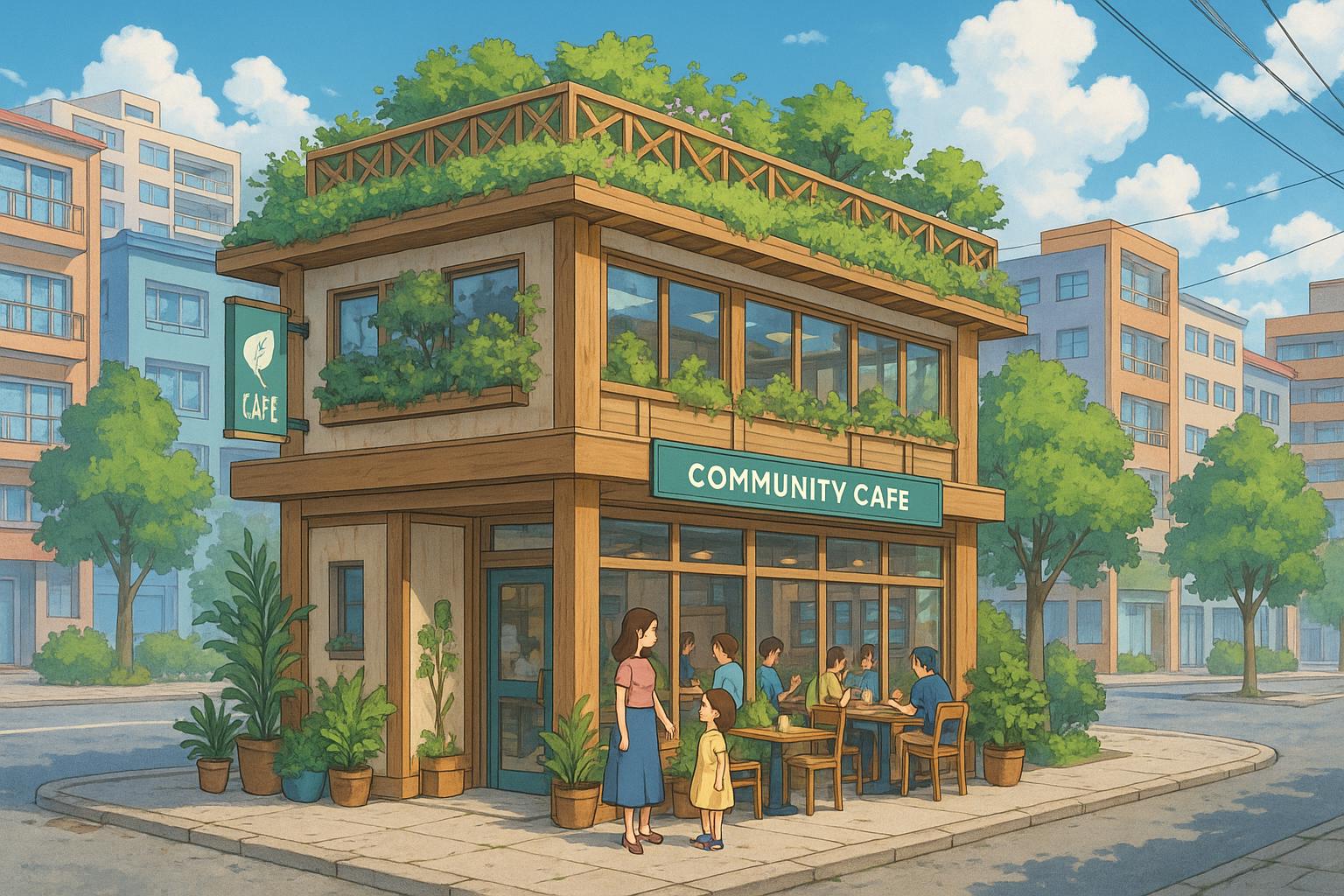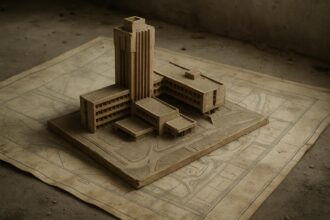Emerging small-scale commercial architecture is proving that impactful, community-centred sustainable design thrives without large footprints, driving environmental responsibility, social engagement, and healthier indoor environments that support local ecosystems and economies.
Small commercial architecture is emerging as a powerful force in the sustainability movement, demonstrating that impactful design does not necessitate vast spaces. This innovative sector is redefining how businesses can operate within their communities by emphasising environmentally and socially responsible practices. Modest in scale yet ambitious in vision, these projects reveal that the smallest architectural footprints can create significant changes within local ecosystems, setting the stage for broader societal impacts.
While larger corporations often seek to make headlines with grand sustainability initiatives, small commercial architecture illustrates that meaningful change frequently originates at the grassroots level. These projects focus on thoughtful design principles that aim to create positive ripple effects within entire communities. By prioritising environmental responsibility and social engagement, small businesses are crafting spaces that do more than serve immediate commercial purposes; they are fostering connections, enhancing social cohesion, and enriching the local fabric.
Community-centric design is a hallmark of this movement, illustrating that the vibrancy of neighbourhoods can be correlated with the ethical practices of local businesses. This approach extends beyond simply offering welcoming spaces; it encompasses the integration of community gardens, workshop areas, and multifunctional venues that cater to local needs. For instance, retail environments increasingly include areas for collaboration and cafés are transformed into communal spaces that not only provide sustenance but also foster interactions among residents. Such developments signify a shift where small commercial spaces morph from mere storefronts into vital components of their neighbourhoods.
A related trend is the concept of “third spaces” — environments where the boundaries of work, relaxation, and socialisation blur. These spaces are designed to be adaptable, serving as co-working hubs during the day while transforming into event venues at night. Cafés might double as libraries or communal meeting places, creating an ecosystem that encourages community interaction and cultural vibrancy. From an economic perspective, this diversification enhances the ability of small businesses to thrive, promoting a dynamic and robust entrepreneurial network within urban settings.
The emphasis on the circular economy further amplifies the impact of small commercial architecture. This principle, ingrained deeply in sustainable design, focuses on keeping resources in use for as long as possible. Small businesses can adopt this approach by selecting recycled materials, minimising waste, and considering the entire lifecycle of their spaces. For example, restaurants utilising reclaimed timber for furnishings not only minimise environmental impact but also make a powerful statement about their commitment to sustainability. In this context, embracing circularity is not just an aesthetic choice but a strategic business move that aligns with the increasing expectations of environmentally-conscious consumers.
Moreover, the focus on indoor environmental quality has become critical, particularly in smaller spaces where air quality directly influences the wellbeing and productivity of occupants. Architects are now prioritising low-VOC (Volatile Organic Compound) materials and incorporating natural ventilation strategies to enhance air quality and create inviting atmospheres. The movement towards healthier indoor environments is supported by advancements in technology, such as the use of IoT devices to monitor air quality and adjust conditions in real-time, ensuring a fresh and revitalising experience for users.
These trends collectively reinforce the idea that small commercial architecture can have an enormous impact on the environment and local communities. By fostering connections, enriching neighbourhoods with multifunctional spaces, advocating for circular economy principles, and prioritising occupant health, these architectural practices exemplify the profound influence that even the smallest designs can have in today’s world. The industry is poised for innovation, inviting architects and designers to push the boundaries of sustainable design, encouraging them to explore new solutions that can inspire future generations.
Now is the time for designers to showcase innovative projects and contribute to this crucial dialogue in sustainable architecture.
 Reference Map:
Reference Map:
- Paragraph 1 – [1], [6]
- Paragraph 2 – [1], [2], [4]
- Paragraph 3 – [3], [5]
- Paragraph 4 – [2], [4], [7]
- Paragraph 5 – [1], [3], [5]
- Paragraph 6 – [1], [6]
Source: Noah Wire Services
- https://www.architectureanddesign.com.au/editorial/sustainability/small-footprint-enormous-impact-sustainability-trends-in-small-commercial-architecture – Please view link – unable to able to access data
- https://apxconstructiongroup.com/2025-commercial-interior-design-trends/ – This article discusses the integration of sustainability in commercial interior design, highlighting the use of sustainable materials like reclaimed wood and recycled metals, energy-efficient lighting and HVAC systems, and waste reduction through modular furniture. It also emphasizes the importance of indoor air quality and occupant well-being, noting that low-VOC paints and natural ventilation strategies contribute to healthier environments. The piece underscores that these practices are not only environmentally responsible but also cost-effective, aligning with the principles of the circular economy.
- https://www.auromaarchitecture.com/post/commercial-architecture-trends – This piece outlines key trends in sustainable commercial architecture, including energy efficiency achieved through optimized lighting and HVAC systems, the use of eco-friendly materials such as recycled steel and reclaimed wood, and designs that enhance employee well-being by incorporating natural lighting and biophilic elements. It also highlights the rise of flexible and adaptive workspaces, biophilic design, and health-centric architecture, all contributing to more sustainable and human-centric commercial environments.
- https://www.2future.co/post/trends-sustainable-architecture – This article explores sustainable architecture trends, focusing on passive design strategies that utilize natural resources for energy efficiency, the adoption of circular economy principles to minimize waste and maximize resource efficiency, and the integration of smart technology and automation to enhance building performance. It also discusses the role of the Internet of Things (IoT) in monitoring and improving indoor environmental quality, contributing to healthier and more sustainable built environments.
- https://pmc.ncbi.nlm.nih.gov/articles/PMC11057716/ – This research examines the role of Interior Environmental Quality (IEQ) in green building design, emphasizing factors such as air quality, lighting, thermal comfort, and acoustics. It discusses how IoT technology can enhance IEQ by monitoring and controlling indoor conditions, leading to improved occupant health and productivity. The study highlights the importance of integrating IoT solutions to create healthier and more sustainable indoor environments in green buildings.
- https://foyermagazine.com/the-rise-of-eco-friendly-architecture-green-building-trends/ – This article highlights the rise of eco-friendly architecture, focusing on green building trends such as passive house design, biophilic design, and circular economy practices. It discusses how these trends aim to minimize energy consumption, reconnect occupants with nature, and promote resource efficiency. The piece provides examples of projects that embody these principles, illustrating the growing emphasis on sustainability in architectural design.
- https://architectureindustry.in/sustainable-architecture-takes-center-stage-industry-trends-for-the-new-year-202201210936/ – This article discusses the prominence of sustainable architecture, highlighting trends such as net-zero energy buildings, biophilic design integration, and circular economy practices. It provides examples of projects that exemplify these trends, illustrating the industry’s shift towards environmentally responsible and resource-efficient design. The piece emphasizes the importance of these trends in addressing global challenges like climate change and urbanization.













